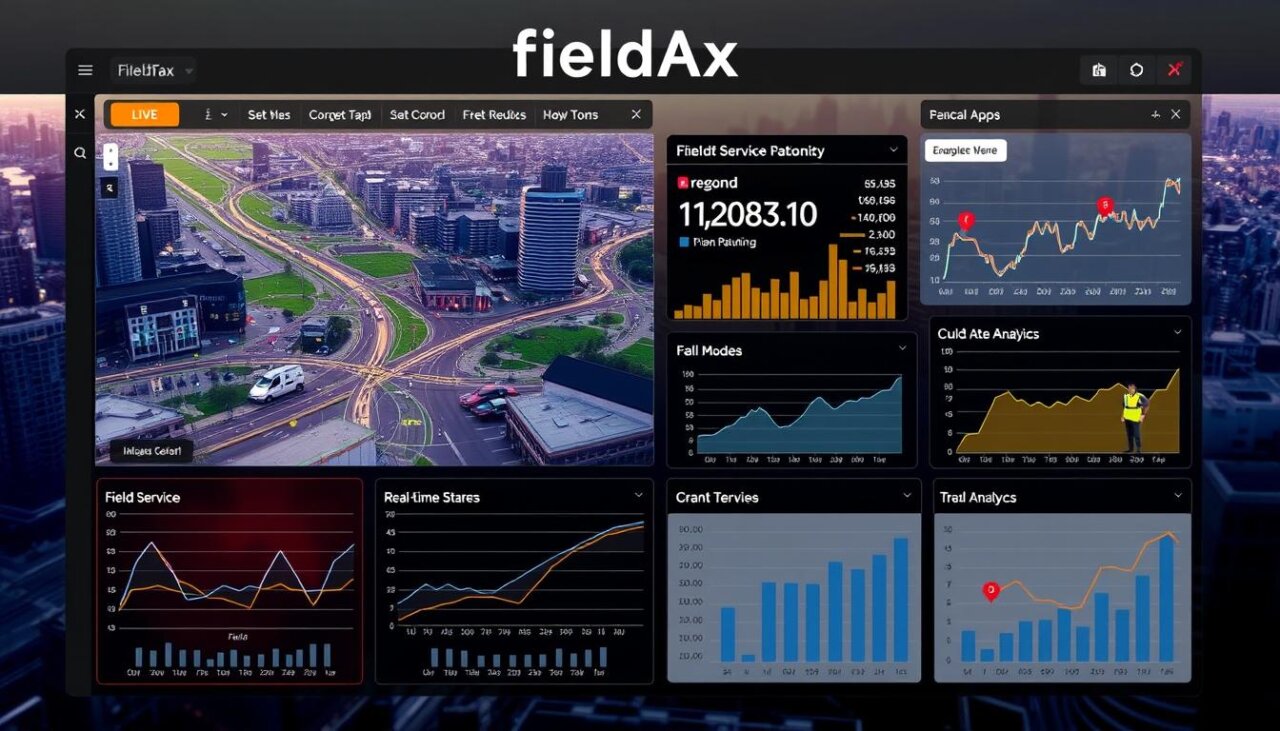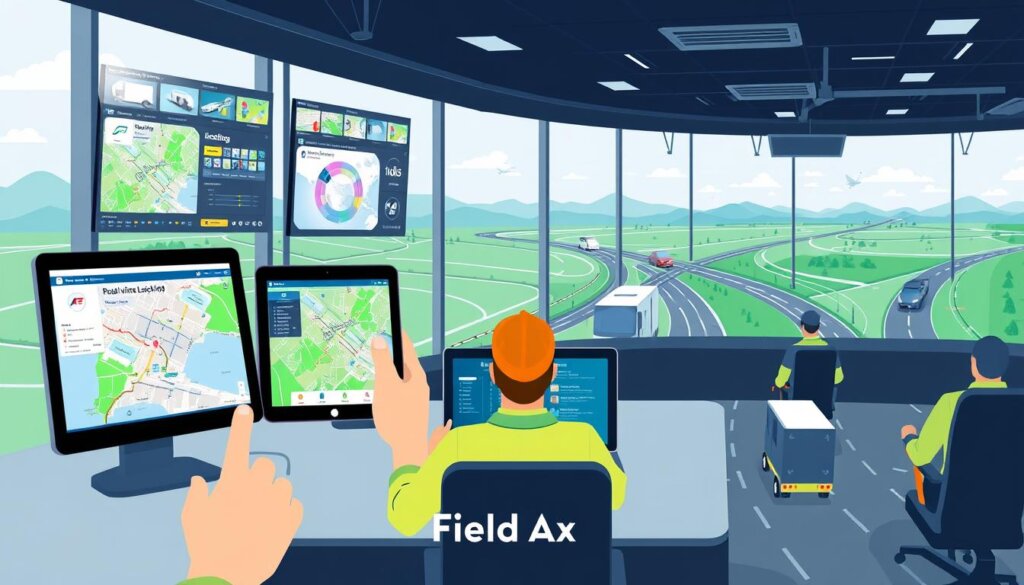Did you know that businesses can lose up to 30% of their revenue due to inefficient field service operations? Managing field resources well is key to staying competitive. Fleet tracking technology is a crucial solution. It helps by using real-time data to better deploy field workers and assets.
This leads to big improvements in productivity and customer happiness.
The use of GPS tracking and advanced software has changed field service operations. These technologies help make operations more efficient, improve employee responsibility, and make service delivery smoother. This section will explore how fleet tracking is essential for a well-organized and quick field service setup.

Key Takeaways
- Fleet tracking maximizes productivity optimization in field service.
- Real-time data enhances the efficiency of resource management.
- Advanced tracking systems improve employee accountability.
- Efficient field service operations directly impact customer satisfaction.
- GPS technology is integral to optimizing field workforce deployment.
Understanding Fleet Tracking Technology
Fleet tracking technology is key for modern businesses to improve their operations. It lets companies watch vehicle and field worker locations in real time. This boosts efficiency and safety. Knowing how fleet tracking works is crucial for using it well.
What is Fleet Tracking?
Fleet tracking uses advanced systems to keep an eye on fleet vehicles and workers in real time. It uses GPS to track assets, helping companies make better decisions. This technology combines GPS, telematics, and communication tools to make processes smoother and more productive.
Key Components of Fleet Tracking Systems
The success of fleet tracking depends on its main parts. These include GPS devices for exact location data, telematics for vehicle analysis, and communication tools for data sharing. These parts work together to help manage fleets effectively. Understanding these components helps businesses use fleet tracking to improve their operations.
Benefits of Fleet Tracking in Field Service Management
Fleet tracking brings many benefits to field service management. It helps organizations understand their field workforce better. This leads to improved productivity and service quality.
Increased Visibility of Field Workforce
Fleet tracking makes it easier to see where your field team is. Companies can watch employee locations and progress in real-time. This makes operations smoother and ensures quick responses to customers.
This level of monitoring also encourages team members to be more accountable. It helps everyone stay on track and work together better.
High-Quality Resource Allocation Optimization
Optimizing resource allocation is key to better operations. Fleet tracking helps businesses manage their schedules and resources more effectively. This means less downtime and lower costs.
With better resource management, companies can see a rise in their profits. It also boosts overall productivity.
Improved Safety and Compliance
Fleet tracking also improves safety and compliance in field service. It lets companies watch driver behavior. This ensures they follow safety rules and find areas for training.
As a result, workplaces become safer. Companies also reduce risks and costs from accidents and insurance claims.
Managing Field Resources Efficiently: The Impact of Real-Time Data Analysis
Real-time data analysis is a game changer for managing field resources. It helps organizations improve operations with GPS tracking solutions. These technologies let me track vehicle performance, like speeds and routes.
This data is key for better field operations. It leads to smarter decisions and more efficiency.
Leveraging GPS Tracking Solutions
GPS tracking solutions make real-time data analysis easy. I can watch my fleet’s location and performance. This gives me insights to improve service delivery.
For example, knowing traffic patterns helps me use resources better. This cuts costs and reduces idle time. It makes my workforce more productive.
Making Data-Driven Decisions
Real-time data analysis helps me make better decisions. I can spot areas for improvement and adjust strategies. This is vital for better field service management.
In today’s fast world, quick responses are key. It keeps my team competitive and effective.
Enhancing Field Workforce Efficiency with Fleet Tracking
Fleet tracking is key to making field work more efficient. It helps businesses cut down on how long it takes to respond to customers. This is because they can track where their teams and vehicles are, sending help fast when needed.
Customers are happier because they get help quicker. This is crucial in today’s fast-paced world.
Improvement in Service Response Times
Fleet tracking makes it easier to find and send out teams quickly. This means urgent jobs get done fast. Customers love this because it’s faster than they expect.
This leads to happier customers. It also makes businesses run smoother by cutting down on delays.
Streamlining Workflow and Operations
Fleet tracking does more than just speed up responses. It also makes workflow better by managing operations well. Companies can plan better using real-time data.
This leads to a more efficient process. Using these technologies helps businesses improve in many ways, not just logistics.
Mobile Field Service Solutions and GPS Tracking
In the fast-changing world of field service management, using mobile solutions with GPS tracking makes things better. These tools help teams talk smoothly and share updates in real-time. This means companies can meet customer needs faster and serve them better.
Implementing Mobile Applications for Better Coordination
Mobile apps help teams work together better. They give field workers the tools they need right when they need them. This keeps everyone connected and helps manage schedules and make quick decisions.
Integrating Fleet Tracking with Other Software Solutions
Linking fleet tracking with other software makes managing resources easier. This integration makes work flow better across different teams. It also helps share data, making it easier to coordinate field services and use resources wisely.
Remote Workforce Management: Strategies and Tools
In today’s fast-changing work world, managing remote teams well is key. Companies must use new strategies to keep productivity high and everyone accountable. They need to use technology to improve how they manage their teams.
Adapting to a Changing Work Environment
The move to remote work has made it clear that old management ways don’t work. New strategies must fit different team setups and remote work styles. Leaders should talk often, set clear goals, and make everyone feel part of the team.
Boosting morale and keeping productivity up is important. Using the right tools for remote management can help a lot. It makes sure everyone is on the same page and working well together.
Tools to Enhance Remote Management
Using top-notch remote management tools is vital for a team spread out. Tools like project management software and collaboration platforms help keep everyone in sync. They also let companies track how well things are going.
This helps make better decisions. With the right tools, companies can manage their remote teams better. This leads to better work and more success.

Challenges in Implementing Fleet Tracking Solutions
Starting to use fleet tracking solutions can be tough. A big problem is figuring out the costs. It’s key to understand the money side to make it work.
This means looking at the costs of hardware, software, and training. At first, it might seem like a lot. But, the benefits over time are worth it.
Cost Considerations
First, you need to do a cost analysis. This helps you see what money you’ll need to spend. Costs include buying tracking devices, software, and training for your team.
Even though it might seem expensive at first, the savings later on are big. You’ll use less fuel and work more efficiently.
Overcoming Resistance to Change
Another big challenge is getting people to accept new technology. Employees might worry about changes to their work. It’s important to show them the good side of fleet tracking.
Telling stories of how it helped others can help. It shows how it can make work better, safer, and more satisfying. A supportive team can also make it easier for everyone to adapt.
Case Studies: Successful Implementation of Fleet Tracking
Looking at case studies on fleet tracking shows how it changes service companies. It shows how using fleet tracking technology improves operations and service. This leads to big benefits and better service delivery.
Example 1: Service Company A
Service Company A changed its operations with fleet tracking. They used advanced tracking to make their work more efficient and cut costs. This led to better decisions and more productivity, making customers happier.
This success story is a guide for other companies wanting to improve. It shows how fleet tracking can make a big difference.
Example 2: Service Company B
Service Company B’s service got much better with fleet tracking. They could track service requests and team movements better. This made customers very happy.
The company also saw better communication and teamwork. This shows how fleet tracking can really make a difference in service quality.
Conclusion
Managing field resources well is key to better field service operations. This article looked at the good and bad sides of fleet tracking. It showed how it can improve visibility, efficiency, and safety in companies.
By using new tech, businesses can turn field service data into useful information. This helps improve how they work.
Looking at real-time data, mobile tools, and GPS tracking shows how to make better choices. Using data to improve productivity and make processes smoother is crucial.
Using fleet tracking technology helps companies do well in today’s fast world. It lets them keep an eye on resources and act fast. This way, they can reach their goals safely and follow rules, making field service work better.
See how FieldAx can transform your Field Operations.
Try it today! Book Demo
You are one click away from your customized FieldAx Demo!
FAQ
What is fleet tracking and how does it work?
Fleet tracking uses technology to track vehicles and field workers in real time. It combines GPS, telematics, and software. This setup allows for easy data sharing, making field service management better.
What are the benefits of using fleet tracking in field service management?
Fleet tracking helps manage field services by making the workforce more visible. It also optimizes resource use, boosts safety, and increases productivity. Plus, it makes customers happier.
How does real-time data analysis impact managing field resources?
Real-time data analysis is key for managing field resources well. GPS tracking helps gather important data. This data lets organizations make better decisions, like better routes and less idle time.
What role does mobile technology play in field service operations?
Mobile technology, with GPS tracking, changes field service operations. It gives updates on job status and improves communication. This makes coordination and efficiency better.
What strategies can be employed for effective remote workforce management?
To manage remote work well, use advanced tracking systems and communication tools. Also, keep team morale high and ensure accountability among field workers.
What are the challenges of implementing fleet tracking solutions?
Challenges include the cost of hardware, software, and training. Also, getting employees to accept change is hard. Good communication about the benefits is key.
Can you provide examples of successful fleet tracking implementation?
Yes, many companies have seen big improvements with fleet tracking. For example, a service company better used its resources. This led to better service and happier customers.
Author Bio
Co-Founder & CMO at Merfantz Technologies Pvt Ltd | Marketing Manager for FieldAx Field Service Software | Salesforce All-Star Ranger and Community Contributor | Salesforce Content Creation for Knowledge Sharing






